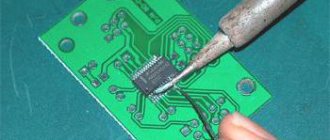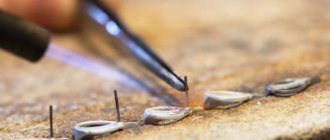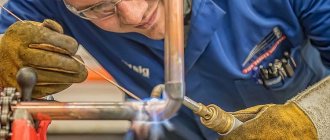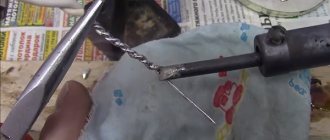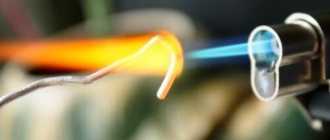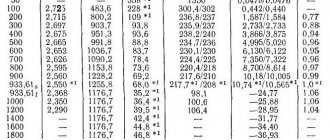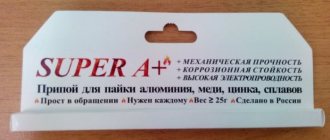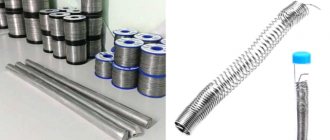How to replace solder
Solder at home can be replaced with:
| Solder option | Description |
| Aspirin | Probably the most affordable option, since it can be found in every first aid kit. To carry out high-quality soldering, be sure to use only a highly concentrated solution. It is also important to consider that soldering with acetylsalicylic acid is accompanied by an unpleasant odor. Therefore, it is important to ensure good ventilation; the room should be well ventilated. |
| Fat | An affordable product with low cost. The main disadvantages of fat are its consistency and unpleasant odor. However, it melts easily and spreads across solder joints. When considering options for replacing solder for soldering, fat cannot be ignored. |
| Resin | It is better to use tree resin, especially coniferous ones. It is a non-aggressive substance that is easy to melt and spread over the surface. Can be used for various soldering and tinning applications. |
| Amber | Exotic and expensive option. However, due to its similar characteristics to rosin, it is the best option for soldering at home. The main disadvantage is low availability. Finding amber is not so easy. |
| Rosin for instruments | Used for rubbing the bows of musical instruments. However, it can be used for soldering, since it has characteristics similar to ordinary rosin. |
Sometimes it happens that you need to find a way to replace solder for soldering, since you don’t have regular rosin at home. At home, you can use many fairly relevant options, some are more affordable, others, on the contrary, will be more difficult to find.
Even acetic and citric acids provide a weak effect, so they can also be used for soldering.
Technology of working with solder of aluminum and its alloys
The parts must be cleaned of dust, grease, dirt and placed in the position in which they will be soldered. You need to apply flux to the place where soldering will be carried out.
The area with flux heats up. To do this, you need to touch the surface with the rod. It is important not to overheat the joint, as the metal will melt.
IMPORTANT TO KNOW: Device for bending profile pipes
When working with solder without flux, it is worth knowing a feature: the oxide film on the surface must be destroyed, since the solder will not be able to penetrate through it.
You can destroy it using a stainless steel or a steel rod; to do this you need to scratch the surface. As a result, the oxide film loses its integrity.
If the surface is large, then a steel brush will help to destroy the film. You need to move it along the surface, then connect the parts together.
The problem with aluminum is that an oxide film forms instantly after it is cleaned off. It is inert and is difficult to wet with molten metal.
What should you do to remove such a film and firmly solder the part? You can clean the surface by pouring a layer of oil on it. In this case, the metal will not come into contact with air, and therefore a film will not be able to form.
Video:
Water should not be part of the oil. To do this, it is well heated to a temperature of 180-200 degrees. Experts recommend using vacuum and mineral oils.
There is another way to remove the oxide film. Cover the surface with rosin. It, like oil, will prevent air from reaching the metal.
Using steel filings or a stainless steel brush, you need to make scratching movements on the aluminum; the film will lose its strength.
The best method to remove the oxide film with your own hands is to use mechanical action with steel elements plus exposure to active flux.
Using soldering, you can restore aluminum objects of any design, size, or complexity. This repair method is used not only for household items.
Cars, motorcycles, and other equipment are subject to increased strength requirements. They can also be repaired by soldering.
Sometimes this method of connecting parts is preferable to welding. After all, it does not deform the metal or change its composition.
By soldering, you can repair air conditioners and pumps.
At home, you can restore aluminum gutter, siding, stairs, dishes. After repair, the alloy will be very durable.
Using Alternative Soldering Media
Soldering work is standard for any chosen product; differences can only be observed at the preparatory stage:
- the fat must be melted or heated;
- prepare a solution from aspirin;
- No preparation is required for resin, amber, and bow rosin.
The use of analogues cannot be a complete replacement for soldering rosin, however, when you don’t have it at hand, they will be an ideal way to achieve the desired result.
You also need to take into account that home methods are not suitable for production purposes. The quality of soldering will be significantly worse than when using standard soldering.
How to make solder at home
Many radio amateurs know how to make solder for soldering. To do this, you need to know the characteristics of solders and the ratio of elements. Scrap metal or waste parts from devices, batteries, coins, etc. can be used as raw materials. What can be used as solder, and where to find the substances:
- Tin can be removed from light bulbs or circuit boards of old unnecessary equipment. The walls of food cans and lids are covered with a thin layer.
- Lead is found in a pure state in batteries, cables, and car wheels.
Low-melting metals are used as solders (relative to the melting point of the parts being connected). These are mainly two-component alloys, less often 3-component. The ratio of these elements is of primary importance: with an increase in the content of a more fusible metal in the composition, the melting point decreases, and vice versa. We'll tell you in this article how to make silver solder at home, the most refractory of all existing ones.
Mastering soldering with rosin
The composition of rosin for improving soldering is manufactured and sold both in pure solid form and in the form of liquid or viscous fluxes, its price varies.
The most common is alcohol-rosin flux (brand “SKF”), which according to GOST consists of a 40% rosin solution and pure ethyl alcohol.
It is this flux with rosin that is a dielectric, unlike ammonium chloride flux. In addition to the technical properties of this flux, the low price is important.
Video:
Instead of liquid flux, you can use solid rosin; it is also available in stores for radio amateurs.
The price of one kilogram of solid rosin ranges from 400 to 500 rubles. When rosin is purchased, a soldering iron and regular solder (tin) are available, we get to work.
If you have not had to solder before, then first read the video instructions. The technology of soldering using rosin is presented in the video.
IMPORTANT TO KNOW: How to solder brass at home?
To solder firmly and correctly, follow the following sequence.
Soldering iron preparation - tinning. It involves stripping the soldering iron tip with files and then coating it with a thin layer of solder.
Warm up the tip and put a small amount of rosin on it, then immediately connect it to the solder. As you can see in the video, the solder does not stick to the tip, and we need to ensure that it is evenly covered with solder.
Therefore, we apply the sting to a natural board (pine is best, but you can use any) for a short time. We repeat the sequence.
After several cycles we will achieve the desired result. Preparation of surfaces to be soldered.
Let's tin the wire, to do this we will clear it of the insulating layer, but only as much space as we need for soldering.
If a larger surface of the wire is exposed than is required for soldering, then this, of course, is convenient for a beginner; this is precisely the reason why short circuits and fires occur in the circuit.
Typically, pure copper wire can be tinned after one rosin-solder cycle.
Let's dip the wire in rosin, apply a hot tip to the top of the bare surface and lift the wire.
The rosin mass will smoke and flow around the wire, after which all we have to do is cover the soldering area with tin. To do this, pick up tin from the solder with a hot tip and transfer it to the wire.
If the wire turns from copper-yellow to silver, then it is considered correctly tinned. When you need to connect two wires by soldering, both need to be tinned in the same way.
Video:
Let's look at how to prepare a copper part for soldering to which you need to solder a wire. Dip the heated tip into the rosin and immediately into the solder.
Now we have a rosin-tin mixture at the tip of the sting. It needs to be thoroughly rubbed over the surface of the part at the soldering site.
Tinning is done correctly if the place where soldering will be done turns silver.
Instead of solid rosin, you can use any flux.
In order to properly solder the tinned parts, we connect them together, pick up tin with a heated soldering iron (it can be replaced with any other clean solder), and cover the joint of the parts with a hot compound.
If it was not possible to enrich the joint of the parts immediately, then you can touch the soldering iron with tin again.
Now avoid moving the parts under the hot solder and allow the soldering to cool completely. The parts are coated in tin using rosin.
IMPORTANT TO KNOW: Technique for welding aluminum at home with an inverter
If you notice that the enveloping is not going well, then add as much rosin as required, but in small portions.
Let's look at how to properly unsolder parts. We heat up the tip and apply it to the soldering area. This will melt the solder and the parts will easily separate from each other.
Now dip the brush into the solvent and remove the remaining flux and rosin from the surface of the parts.
Types and features of solders
Important! Low-melting solders up to 450° C are applied using a soldering iron, refractory solders (up to 1100° C) are fused with a gas torch.
To avoid damage to the product, you can learn how to make solder at home. There are 3 main types.
A large proportion of solders used for soldering electronics are tin-based. The second and essential component is lead. Depending on the proportions, the properties of the solder differ: the higher the lead content, the higher the melting point. To increase the strength and melting temperature, a third element can be added to the solder: cadmium, antimony.
Lead-free solders are a new development by chemists. Such solders are made on the basis of tin, but with the addition of silver, cadmium, zinc, copper, and aluminum. All tin-based solders have high adhesion to metal surfaces. They wash off well with acids and also allow you to work with a large number of metals. They are classified as low-melting and are marked with PIC indices.
Solid
Among refractory alloys, only two groups are distinguished and widely used. These are mainly copper or silver alloys.
The first group includes solders made of copper and zinc. They are well suited for those connections that will only be subject to static loads. The fragility of these alloys does not allow their use in components that will experience shock or any vibration.
Copper solders or zinc-based compounds include PMC-36 and PMC-54. The first is an ideal solder for soldering brass and any other copper joints. The second is suitable for working on copper, bronze or steel parts.
If you need to connect two steel parts together, then you can use pure copper, brass grades L-62, L-62, L-68. These brass-based solders create stronger, more ductile joints. Copper alloys do not have these characteristics.
Silver alloys are considered the highest quality. The composition may also contain zinc and copper. PSR-70 – solder for soldering copper, for working with brass or silver parts. This element is suitable if the connection point must conduct electricity. PSR-65 is used in the production of jewelry, fittings, and water pipes. PSR-45 is necessary for connecting those parts that operate under vibration and shock loads.
Manufacturing instructions
We prepare solder for soldering silver with our own hands. Since a burner is used to melt refractory elements, we do this in a garage or workshop. Silver solder consists of 2 elements:
- silver in the amount of 3 grams;
- brass (copper + zinc) 1 gr.
Silver must be as pure as possible - 925. As brass, you can use broken brass products and coins. Or take a ratio of 70% copper and 30% zinc. The two-component alloy should be in exactly this ratio, since when the zinc content increases to 40%, brittleness increases.
It is necessary to melt the elements first of all that have a high melting point and add the rest as they decrease. The melting point of copper is 1080° C, silver – 930° C, zinc – 420° C.
To produce homemade solder, we will need a small mold and a bowl in which we will melt. It's best if it's cast iron. Warm up the mold and add a little wax to it, heat the bowl. If we use ready-made brass, then melting begins with silver. If these are 3 separate elements, then we start melting with copper. If the melting is not complete, add silver; when mixing, the process begins to happen faster. Finally add zinc. Without ceasing to heat the bowl of metal, we pour the resulting melt into the mold. Cooling of the melt occurs very quickly, in a matter of seconds. After crystallization, the resulting workpiece can be cooled.
How can I replace tin solder for soldering? This category is characterized by high ductility and adhesion to metal surfaces. Low refractoriness allows the use of solder for non-ferrous metals and thin parts. A mixture is obtained by mixing tin and lead in their pure form. The elements themselves can be obtained chemically by extracting tin from cans and lids. We do it step by step:
- Pour water into a jar, put it on fire and boil. Mine.
- We connect 3 batteries and a 9-2 volt battery. We connect the positive pole to the jar, the negative pole to metal of any shape (let it be an electrode).
- Fill the jar with sodium hydroxide or soda solution.
- We lower the electrode into the jar, but so that it does not touch its walls.
- Over time, a deposit of pure tin will appear on the anode (electrode).
The method for extracting tin from old circuit boards requires the use of hydrochloric acid followed by leaching.
It is much easier to obtain lead at home; all you need to do is:
- disassemble the old battery;
- find fishing weights or shot;
- disassemble and clean the lead cable;
- finding unnecessary seals from the water meter.
Recommendations for use
Important! Initially, the most refractory metal is melted, after which the remaining components are added in descending order.
Solder is used in 3 types: wire, powder or chips and plate. The choice of shape is determined either by personal preference or by design features.
If you are looking for where to get solder at home, if you don’t have a store-bought one at hand, determine the degree of importance of the product. It is possible that the resulting solder will not match the desired chemical composition and will not provide mechanical parameters.
Conclusion
There are several alternatives to replacing solder. Let us highlight the goals that are achieved by soldering: rigid fastening of parts (for electronics - preserving the conductive ability of the element). This result can be achieved by using the following types of glue:
- epoxy resin;
- glue gun.
The disadvantage of this connection can be considered the high fragility of the resin and the low strength of hot glue. If these shortcomings are unacceptable and there is no solder, then you can make even the most refractory copper solder with your own hands.
Features of use
Having correctly identified and selected the solder and rosin used, you can perform the soldering itself. This work is not particularly difficult. It is necessary to perform appropriate surface preparation, for which the base metal is cleaned of existing contaminants and all settling parts.
When preparing a surface for soldering, it must be heated and the solder melted. Remember that there should not be a large difference in temperature between the metal alloys and the solder, as this will subsequently negatively affect the quality of the connection. There is no need to overheat the base metal; subsequently, the solder can spread over such a hot surface, cooling for a long time and not hardening for 10 minutes or more. The presence of rosin greatly simplifies soldering, and the solder quickly hardens, providing mechanical strength to the connection. This ensures the necessary protection of the connection against corrosion.
Currently, solder with rosin from various manufacturers can be found on sale. These can be both domestic companies and foreign manufacturers. It should be said that there is no significant difference between domestic and foreign manufacturers. Therefore, first of all, focus on the composition of the material, its brand and the thickness of the wire. By purchasing solder from domestic manufacturers, you can save a lot. At the same time, you can be completely confident in the quality and durability of the soldered connections of metal elements.
How to use solder for soldering?
The best solder for soldering metals is pure tin. But in practice, an alloy is used in which tin is the base and lead is added. Similar solders can be found on sale, and there are many brands. If desired, you can make it yourself if all the necessary ingredients are available. Tin and lead solder is designated by three letters - POS, followed by a number. The most popular brands are POS-60 and POS-40. The numbers are the percentage of lead in the mixture. Such solders are used for soldering both brass and radioelements and copper wires.
Hard soldering diagram.
Making solder yourself
To make solder for soldering at home, you will need the following ingredients:
- Lead.
- Tin.
You also need the following tools:
Materials and tools for brass soldering.
- Ceramic forms (can be made of plaster or tin).
- Steel spoon.
- Steel stick.
- Container (preferably steel).
Don't forget that you are working with lead, one of the dangerous metals. Wear goggles and a respirator, ventilate the room. For convenience, wear gloves to avoid getting burned. Melt lead and tin over a gas burner in a container, weighing them on scales in advance and achieving the desired proportion. Using a steel spoon, remove the “fat” - the slag on the surface. And, stirring with a steel rod so that the metals combine evenly, pour the melt into the molds. That's it, the solder for soldering copper wires and radio elements is ready, you can begin installation work. Don't forget to ventilate the room.
Soldering fluxes
During the operation, flux plays no less a role than solder. It is a chemical solvent and oxide absorber. It also protects metals from oxidation and increases wetting.
To work with elements based on lead and tin, hydrochloric acid and zinc chloride can be used as a flux. Borax and ammonium chloride are also suitable. These are active fluxes. Inactive substances include rosin, petroleum jelly, olive oil and many other substances.
For example, hydrochloric acid solutions can be used with soft solders. Zinc chloride is used with brass, copper, and steel. Ammonia sleeps perfectly dilutes and dissolves fatty substances. For aluminum, a composition of tung oil, rosin, and calcined zinc chloride is used. You can also use concentrated phosphoric acid.
So, we found out what solders exist, and which one is better to use in different cases.
How to solder brass correctly?
With amateur radio solders everything is very clear, but sometimes it is necessary to solder more massive parts. It is especially difficult to work with brass elements, since during soldering an oxide film forms on the metal. Zinc also evaporates during heating, since brass contains a large amount of this metal. There is only one way out - you need to solder at a low temperature, using tin and lead solder. But it is necessary to use a flux; the most common one is made from rosin and alcohol.
To solder L-63 brass, you need to use a flux that contains sweat acid and zinc chloride. Very high mechanical strength cannot be achieved. Compared to soldering copper, the strength of brass will be half as strong. This is largely due to the fact that the seams have a porous structure. Moreover, pores are formed with any soldering method, both at high and low temperatures. Soldering brass in a gas environment is often used (provided that fluxing was carried out before starting work). It is permissible not to use flux if there is a layer of nickel or copper on the surface of the brass.
In a salt bath at a temperature of 850 degrees, you can solder brass elements. The main thing is to add a little flux to the saline solution, which contains potassium fluorobate. Flux should be approximately 4-5% of the total mass of the brine solution. Flux is needed to ensure that the solder penetrates as best as possible into the gap between the parts being joined.
Copper-rich brass can be soldered with the following solders:
Brass, which has a low melting point, requires the following soldering alloys:
For soldering brass, which has a high percentage of zinc, use PSR-40 solder grade.
It is impossible to use copper-phosphorus solder, since the connection turns out to be low-plasticity due to the formation of zinc phosphides on the surface of the seam during soldering.
If during operation of elements that are subject to soldering, dynamic and vibration loads do not occur, then it is allowed to use PMC-48 and PMC-36 solder.
Choosing a flux for silver products
To connect silver parts, you need to choose a soldering flux so that it can prevent the appearance of an oxide film and can degrease the soldering area . Soldering silver is very simple: heat the surface of the metal until a protective film is obtained using a gas torch.
Flux for silver has the following characteristics:
- the connection is as strong as possible;
- lack of flammability;
- operating temperature ranges from 520 to 820 degrees.
Where can I get tin?
I need a certain amount of tin - I wanted to cast it here in my spare time. anything.
I just can’t even imagine where they get it.
- pro
- Group: Users
- Posts: 7,654
at non-ferrous metal collection points! outbid, or wait for those who bring))
P.S. steelworker?? are you doing HARD? )) P.P.S. fuck with me?))))
- V-Twin Drag Machine
- Group: Users
- Messages: 2,990
- male chauvinist pig
- Group: Users
- Posts: 8,156
- coffee for me!
- Group: Users
- Posts: 2,283
